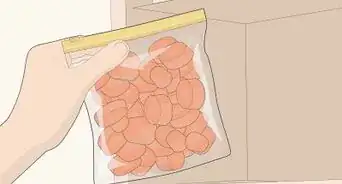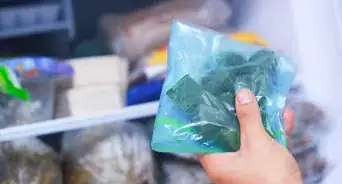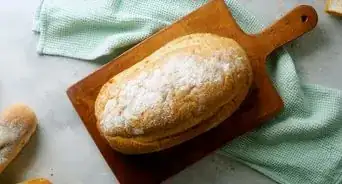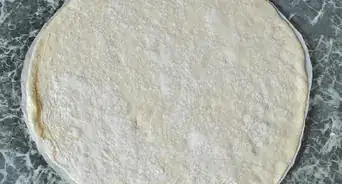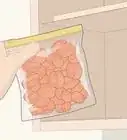This article was co-authored by Jennifer Levasseur. Chef Jennifer Levasseur is a Personal Chef and the Owner of The Happy Cuisiniere based in Breckenridge, Colorado. She has over 12 years of culinary experience and specializes in Mountain and Contemporary Rustic cuisine. Moreover, she can craft dishes and modify menus to accommodate dietary restrictions, such as gluten-free, vegetarian, vegan, pescatarian, and dairy-free diets. In addition to a Bachelor’s degree in Marketing and Management from the University of Houston, Chef Jennifer holds Associate’s degrees in Culinary Arts and Baking & Pastry Arts from Houston Community College.
There are 12 references cited in this article, which can be found at the bottom of the page.
wikiHow marks an article as reader-approved once it receives enough positive feedback. This article received 12 testimonials and 100% of readers who voted found it helpful, earning it our reader-approved status.
This article has been viewed 497,517 times.
If you have more carrots than you can use in the short-term, consider freezing them for long-term storage. To freeze carrots, you must trim them down and blanch to kill potentially harmful bacteria before finally placing them in the freezer. Fortunately, this process is easy enough, and you'll be ready to store carrots in no time!
Steps
Preparing the Carrots
-
1Use good carrots. Choose fresh carrots that are young, tender, and free from any blemishes.[1]
- Medium-length carrots generally work best. True "baby" carrots are a small variety of carrot and do not retain their flavor as well during the freezing process, but technically, they can be used, too.[2]
- If possible, select carrots that were freshly harvested. If you cannot freeze the carrots immediately after they were harvested, you should refrigerate them until you can freeze them.
- Do not use carrots that are limp or dried out.
-
2Wash the carrots. Rinse or scrub the carrots under running water to remove dirt.[3]
- If using carrots harvested from your own garden, you will likely need to scrub them with a vegetable brush to remove the dirt.
- If using store-bought carrots, rinsing them under cold to lukewarm water will usually be enough to clean them.
Advertisement -
3Chop the carrots into smaller pieces. Use a knife to cut the carrots into 1/4 inch (6.35 mm) coins.[4]
- Use a vegetable peeler to shave off the outer layer, revealing the bright orange flesh beneath.
- Trim off the ends. Use a knife to cut 1/4 inch (6.35 mm) or so off both ends. Discard.
- Cut the remainder of the carrot into 1/4 inch (6.35 mm) coins. You could also cut the carrots into thin, Julianne-style strips or other small pieces, but coins are generally the easiest to work with.
- If you do decide to use baby carrots, you do not need to cut them up.
Blanching the Carrots
-
1Boil water in a large pot. Fill roughly 2/3 of the pot with water and set it to boiling over high heat.
- The water needs to reach a strong, rolling boil.
- If you do not have a pot that is large enough to hold all the chopped carrots, work in batches. Finish the blanching process for each batch before beginning the next batch.
-
2Prepare a large bowl of ice water. The bowl of ice water should be at least the same size as the pot of boiling water. Add a minimum of one tray of ice, roughly 12 cubes, to the bowl and fill 2/3 of it with cold water.
- It is important that you have the ice water ready before you begin the process of blanching your carrots.
- If working in batches, you may need to add more ice over time if you notice the first round of ice beginning to melt.
-
3Blanch the carrots in the boiling water. Transfer the prepared carrots to the boiling water and cook them briefly.[5]
- Sliced carrots should only take 2 minutes. Whole baby carrots will take about 5 minutes.[6]
- Blanching restricts certain natural enzymes and bacteria in the carrots, thereby preventing them from changing color, losing flavor, or losing nutritional value.
- You can safely reuse blanching water up to five separate times, but you may need to add more hot water to the pot as time passes.
-
4Quickly transfer the carrots to the ice water. As soon as the required amount of time passes, use a slotted spoon the scoop the carrots out of the pot and into the bowl of ice water.[7]
- Allow the carrots to sit in the ice water for the same amount of time they sat in the boiling water. Generally, this means that sliced carrots need to be cooled for 2 minutes and baby carrots need to be cooled for 5 minutes.
- Cooling the carrots down is essential because it stops the cooking process. You do not want the carrots to be thoroughly cooked.
-
5Drain the carrots. Transfer the carrots to a colander and allow them to drain for several minutes.
- Alternatively, you could also remove them from the water with a slotted spoon and sit them out to dry on layers of clean paper towel.
Freezing the Carrots
-
1Spread the carrots out on a baking sheet. Position the carrots on the baking sheet in a single layer, making sure that they do not touch one another or overlap.
- If the carrots overlap at all, they will end up sticking together upon being frozen. This step is done for the sole purpose of preventing the carrots from sticking together in the freezer, making them easier to measure out and thaw later on.
- If you do not have enough room on the baking sheet for all the carrots, use multiple baking sheets or do this step in batches.
-
2Pre-freeze the carrots.[8] Place the baking sheet of carrots in the freezer for 1 or 2 hours, or until the carrots are frozen solid.
- Pre-freezing the carrots is an optional step. If you plan on using an entire bag or container of frozen carrots at once, you do not necessarily need to freeze the carrots individually. If you do not plan on using the entire batch at once, though, pre-freezing the carrots prevents them from sticking together when frozen for long-term storage.
- The carrots are frozen solid once you cannot cut or break them with a knife.
-
3Transfer the carrots to a freezer-safe container. Slide the carrots off the baking sheet with a flat spatula and transfer them into a freezer-safe plastic container or freezer-safe resealable plastic bag.[9]
- If using a plastic container, make sure that there is at least 1/2 inch (1.25 cm) of empty headspace between the carrots and the top of the container.[10] Food expands as it is frozen, and the extra space allows the carrots to expand as needed.
- If using a plastic bag, make sure to squeeze out as much excess air as possible before sealing the bag. Use a vacuum sealer if you have one.
- Glass containers are not recommended because they tend to crack and break in the freezer.
- Label the container with the current date so that you will know, in the future, how long your carrots have been in storage.
-
4Freeze until ready to use. Carrots retain their quality for roughly 9 months in an ordinary freezer and an ordinary resealable plastic bag or plastic container.[11]
- If using a vacuum-sealed bag and storing the carrots in a deep freeze, carrots will usually last for 14 months without decreasing in quality.
- Frozen carrots are best used in cooked dishes rather than raw dishes.
Community Q&A
-
QuestionCan I freeze peeled carrots?
 Community AnswerYes. Wash, peel, slice, and put them in a boiling water bath for 4 minutes. Then place them in cold water until cool, drain the water, and put them in freezer bags, taking out as much air as possible.
Community AnswerYes. Wash, peel, slice, and put them in a boiling water bath for 4 minutes. Then place them in cold water until cool, drain the water, and put them in freezer bags, taking out as much air as possible. -
QuestionCan I refreeze carrots?
 Community AnswerYes. They won't taste as good, though, and they might be a bit soggy.
Community AnswerYes. They won't taste as good, though, and they might be a bit soggy. -
QuestionCan I freeze carrots immediately after I purchase them?
 Community AnswerYes.
Community AnswerYes.
Things You'll Need
- Vegetable brush
- Kitchen knife
- Vegetable peeler
- Large pan or pot
- Large bowl
- Slotted spoon
- Colander
- Paper towels
- Baking sheet
- Freezer-safe container or bag
- Labels
- Permanent marker
References
- ↑ https://digital.library.unt.edu/ark:/67531/metadc5959/m1/2/
- ↑ https://stilltasty.com/fooditems/index/18950
- ↑ https://www.thekitchn.com/5-times-you-dont-have-to-peel-carrots-tips-from-the-kitchn-220405
- ↑ https://www.thekitchn.com/how-to-cut-carrots-194735
- ↑ https://nchfp.uga.edu/how/freeze/blanching.html
- ↑ http://www.professorshouse.com/Food-Beverage/Topics/Vegetables/Articles/Freezing-Carrots/
- ↑ https://www.thekitchn.com/basic-technique-how-to-blanch-50494
- ↑ http://www.canyoufreezethis.com/can-you-freeze-carrots/
- ↑ https://extension.umn.edu/preserving-and-preparing/vegetable-blanching-directions-and-times-home-freezer-storage
About This Article
To freeze carrots, scrub them with your hands under running water to remove any dirt. If you’re using whole, large carrots, chop them into smaller pieces. Then, blanch them by putting them in boiling water for 2 minutes, or 5 minutes if using whole baby carrots. Remove the carrots and place them in a bowl of ice water for the same amount of time. Drain them, spread them on a baking sheet, and place them in the refrigerator until they’re frozen solid. Then, transfer the carrots to a plastic bag or container and keep for up to 9 months before using. If you want to learn which types of carrots freeze the best, keep reading the article!

